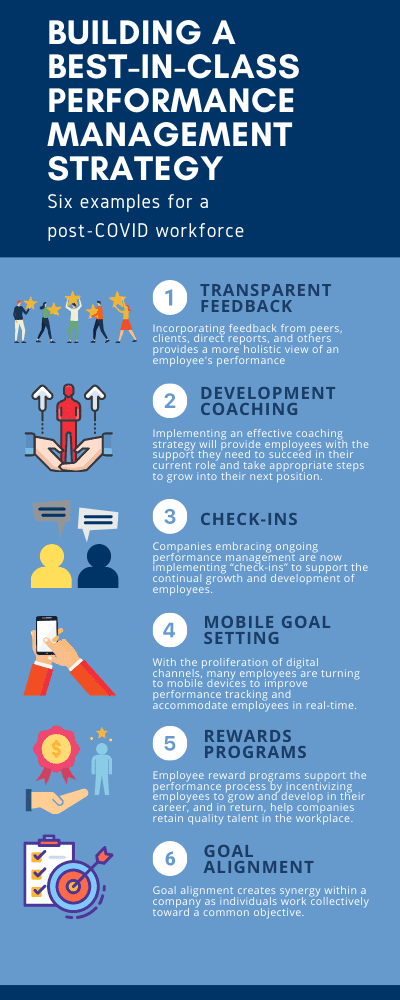As a hybrid workforce becomes the norm, organizations must redefine the way they handle performance management by employing different strategies to make the ongoing performance management process more effective and increase employee engagement.
Here are six examples of how companies are implementing a best-in-class performance management strategy for a post-COVID workforce.

1. Transparent Feedback
Historically speaking, performance reviews have tended to be one-sided. Managers give direct feedback to employees, and employees passively listen. In a remote or hybrid workplace, receiving only manager feedback provides a narrow view of an employee’s performance. By widening the lens, the employee receives a broader more accurate, picture. Incorporating feedback from peers, clients, direct reports, and others enables the employee to better understand how they are perceived by those they work closely with.
TIP: In order to transition to a culture of transparent feedback, upskill employees on how to give and receive feedback that is constructive and highlights strengths and areas for improvement. Additionally, encourage and train managers to be champions of the process and encourage proactive, transparent feedback.
2. Development Coaching
To help retain their workforce, organizations must invest in the development of their employees. Development coaching should occur often and through a variety of formats. Managers should act as coaches, supporting and guiding employees rather than telling them what to do.
TIP: Coaching should be about active listening and appreciative inquiry. Ask questions to learn more information like:
- “What obstacles are getting in the way of success?”
- “Why did you come to this conclusion?”
- “How would you approach that situation differently in the future?”
3. Check-ins
Companies embracing ongoing performance management are now implementing “check-ins” to support the growth and development of employees. While they vary by organization, check-ins are typically informal performance conversations initiated by either the manager or the employee. In a hybrid work model, performance management check-in’s are imperative to stay connected with employees. Many Talent Management systems allow individuals to track progress and record notes from manager check-ins. Check-ins help employees understand how they are progressing against their goals throughout the year versus only receiving feedback during review cycles. It also allows goals to be updated as organizational priorities change.
TIP: Wondering if performance management check-ins are taking place? Measure how frequently your managers are meeting with their direct reports by using a system to record check-ins.
4. Mobile Goal Setting
With the proliferation of digital channels, many employees are turning to mobile devices to improve performance tracking and accommodate employees in real time. If an organization has a performance management solution with a mobile app or responsive design, managers can easily record conversations on-the-go with employees and keep track of goals and progress. This approach simplifies goal management for employees that are working in the field.
TIP: Build an easy-to-find button on your performance management system homepage, so managers can quickly find where to go to track conversations with direct reports and employees can see how they are making progress against their goals.
5. Employee Reward Programs
Employee rewards programs support the performance process by incentivizing employees to develop and grow in their career, and in return, help organizations retain quality talent in the workplace. Many Talent Management platforms have tools that organizations can leverage to track development and performance feedback. For example, companies can provide badges to employees for completing learning courses. They can also allow employees to use badges to recognize their colleagues for strong performance on a project or task. Those badges can be redeemed for specific prizes, and they can be inserted into the employee’s performance review to show they have worked towards developing in their role/careers.
TIP: Encourage healthy competition in the workplace by providing high-value items (think Fitbit, iPad, etc.) to employees who reach a certain number of badges.
6. Goal Alignment
The purpose of goal alignment is to showcase how each employee in an organization is directly affecting the firm. This creates synergy within a company as individuals work collectively toward a common objective. It also ensures that employees create relevant goals that are meaningful to the organization. Providing visibility into what is important to the company and how the individual can contribute, assures the employee that the work they are doing is meaningful.
TIP: Use your organization’s Talent Management system to manage organizational objectives and allow managers and employees to align individual goals to those objectives. Performance Management check-ins are a great time to record progress against individual goals, which in turn update organizational goals so that employees can see company progress.





